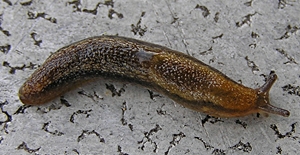
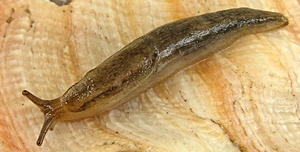
Orange-banded arion (Arion fasciatus, above) and forest a-
rion (Arion silvaticus, below) from Vermont, USA.
Pictures: Harry G. Lee (Jacksonville Shell Club).
  Orange-banded arion (Arion fasciatus, above) and forest a- rion (Arion silvaticus, below) from Vermont, USA. Pictures: Harry G. Lee (Jacksonville Shell Club). |
Part 1: Larger species
Giant red slug (Arion rufus)
Giant black slug (Arion ater)
Lusitanian slug (Arion vulgaris) (Durham slug)
Part 2: Smaller species
Dusky arion (Arion subfuscus)
Forest arion or silver slug (Arion silvaticus)
Orange-banded arion (Arion fasciatus)
Brown-banded arion (Arion circumscriptus)
Hedgehog arion (Arion intermedius)
The Arion hortensis Group
Garden slug (Arion hortensis) (Black field slug)
Dark face arion (Arion distinctus)
![]() Table:
Round back slugs (Arionidae)
- Smaller species.
Table:
Round back slugs (Arionidae)
- Smaller species.
Dusky arion - Arion (Mesarion)
subfuscus (Draparnaud 1805)
![]()
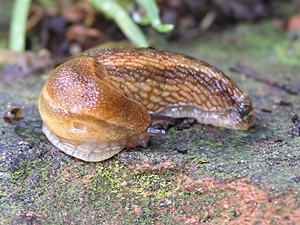 Dusky arion (Arion subfuscus) from Bad Kreuznach, Germany. [RN] |
Description: The dusky arion can have a colouration in different shades of brown: From orange and brown until dark chocolate colour. At the sides, the slug often shows one dark band either side. The colour can also vary inside a population. After hatching, juvenile specimens are dark brown with blackish tentacles, their colour becoming paler some days later. Then they show distinct dark lateral bands and a dark back.
One characteristic identification character for Arion subfuscus is the pale yellow, sometimes even orange, body mucus which can easily be shown with the so-called finger test (the mucus colours the fingers orange). Contrary to that, the sole mucus often can be colourless.
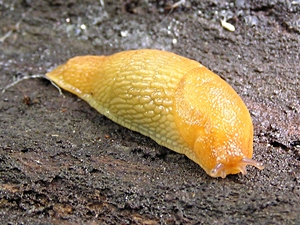 A yellow specimen of Arion subfuscus (?) from Hesse. [RN] |
Especially in the northern part of the distribution area, there are also pale yellow specimens almost without bands.
The genital atrium of Arion subfuscus has about half the diameter of the spherical sperm pouch (spermatheca). The oviduct is quite large and widened, like in Arion vulgaris (see picture).
Dimensions: L: Up to 75 mm.
Habitat and Distribution: The dusky slug mainly is an inhabitant of forests. It is present in deciduous and coniferous forests alike, but also on rocks and in meadows. In anthropogenous habitats, it is rarer, but in the western part of the British Isles, it is quite often present in gardens and at the roadside. In humid weather, the slug crawl up tree trunk. The dusky arion has a quite variable diet: Basically the species seems to live on mushrooms, but dusky arions have also been seen feeding on green and decaying plant matter, fruit and animal droppings. Feeding also on freshly planted young trees, the dusky arion can also inflict a certain damage.
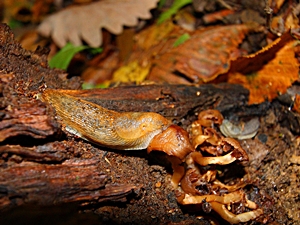 Dusky arion (Arion fuscus) from Lower Austria. Picture: © Alexander Mrkvicka, Vienna (mrkvicka.at). |
Usually the dusky arion is an annual species. In Central Europe, it lays 50 eggs about every one to three weeks. After completion of the egg laying process, the adults die. Until the juveniles hatch, one month until more than a hundred days may pass, depending on the prevailing climate.
The dusky arion's distribution area stretches from the Pyrenees to the Black Sea, in the North to the British Isles and Scandinavia, in the East to the Caucasus and the Ural. On the Italian peninsula, the species is missing. In Greece it is only present in the North, in Turkey only near Istanbul. Altogether, the dusky arion might be one of the most widespread arion species. It is only rare in East Anglia, where it is limited to natural old woods.
Additionally, the dusky arion has been introduced to North America, where it is present at least in the Northwest of the USA and British Columbia (Canada), respectively.
![]() Mollbase:
Arion subfuscus.
Mollbase:
Arion subfuscus.
![]() Francisco
Welter-Schultes:
Arion subfuscus species homepage.
Francisco
Welter-Schultes:
Arion subfuscus species homepage.
![]() Terrestrial Mollusc Tool:
Arion subfuscus.
Terrestrial Mollusc Tool:
Arion subfuscus.
Remark
Arion subfuscus externally is not distinguishable from the closely related species Arion fuscus (O.F. Müller 1774). It is assumed that Arion subfuscus mainly is distributed in the est of Europe and that the distribution area of Arion fuscus follows that of the former species in the East. In Eastern Austria, such as in Lower Austria, most probably Arion fuscus is to be encountered.
Molecular genetic studies of the very widespread and diverse dusky arion have yielded the result that there several populations are developing which can be isolated genetically. This might in the future lead to an allopatric speciation, even if today the isolation has not progressed far enough.
|
|
Pinceel, J.; Jordaens, K.; Backeljau, T. (2005): Extreme mtDNA divergences in a terrestrial slug (Gastropoda, Pulmonata, Arionidae): accelerated evolution, allopatric divergence and secondary contact. J. Evol. Biol. 18 (5) : 1264 - 80 (PDF, 1138 KB) |
Forest arion or Silver slug - Arion (Carinarion)
silvaticus Lohmander 1937
![]()
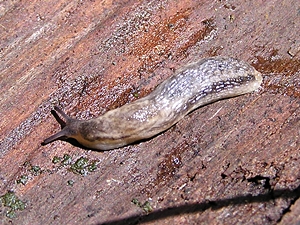 Forest arion or silver slug (Arion silvaticus) from Hesse. [RN] |
Description: The forest arion is a small slug with a light grey to greyish brown, but not yellowish colour, whitening towards the foot seam. Along the sides there are distinctly bordered darker bands. The foot sole is whitish or cream coloured. Often there may be a light dorsal keel. The slug's mucus is clear or light yellow. Juvenile forest arions are light bluish grey with weak and blurred darker bands and a whitish keel line between mantle shield and tail end. In phases of dormancy, forest arions often are contracted and then resemble an isopod or woodlouse.
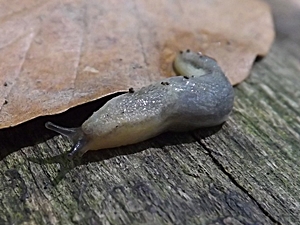 Forest arion (Arion silvaticus) from the Vienna woods. Picture: Martina Eleveld. |
In the slug's genital apparatus, the genital atrium is very large and flattened, the epiphallus is broader than the spermioduct (Vas deferens). The oviduct is wide, the seminal pouch (spermatheca) is elongate and almost arrow-shaped.
Dimensions: L: Up to 40 mm.
Habitat and Distribution: Arion silvaticus lives in shady and protected places in the ground litter of humid deciduous, mixed and coniferous forests of lower mountain ranges. In the North, it is also found in forest areas in the moors. The forest arion, other than most snails, is also found in non-calcareous areas poor in nutrients. In Switzerland, Arion silvaticus lives in altitudes of up to 2400 m MSL. The slugs mainly feed on dead leaves.
The distribution area of the rather frequent species covers Northern, Western and Central Europe, as far south as Southern Bulgaria, in the North until Iceland and the Faeroe Islands.
![]() Mollbase:
Arion silvaticus.
Mollbase:
Arion silvaticus.
![]() Francisco
Welter-Schultes:
Arion silvaticus species homepage.
Francisco
Welter-Schultes:
Arion silvaticus species homepage.
![]() Terrestrial Mollusc Tool:
Arion silvaticus.
Terrestrial Mollusc Tool:
Arion silvaticus.
Orange-banded arion - Arion (Carinarion)
fasciatus (Nilsson 1837)
![]()
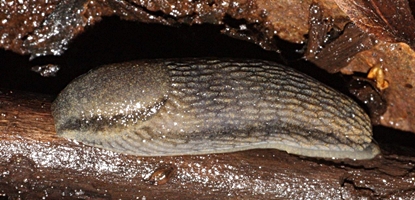 Orange-banded arion (Arion fasciatus) from Norway, resting in the leaf litter. Picture: Magne Flåten (Wikipedia). |
 Arion fasciatus and Arion hortensis. Source: Livinglandscapes.bc.ca. |
Description: The orange-banded arion is a small slug with a yellowish grey or brown colour, whose flanks are more lightly coloured, dark and usually blurred lateral bands bordered in yellow. The band on the right side stretches above the respiratory opening. Near the foot seam, the colour becomes almost whitish. The yellowish ground colour distinguishes this species from Arion circumscriptus and Arion silvaticus. On the back, the slug may have a very slight keel. When contracted, the slug, in cross-section maintains a bell shape, different from Arion hortensis, for example. Juvenile specimens are light greyish brown with darker bands and a more prominent dorsal keel.
The genital atrium is rather large, the epiphallus is wider than the Vas deferens. The oviduct is very narrow and as long as the epiphallus. The seminal pouch is elongate and not rounded.
Dimensions: L: Up to 50 mm, exceptionally up to 70 mm.
Habitat and Distribution: The orange-banded arion mainly lives in open habitats, apart from gardens and fallow land, it can also be found in shady places below trees and bushes, in herbs and in the leaf litter. In Switzerland, the species lives in altitudes of up to 1300 m MSL.
The orange-banded arion's distribution area extends from Northern, Western and Central Europe down to Southeast Europe (Croatia, Bosnia, Albania and Bulgaria). The species was also introduced in North America.
![]() Mollbase:
Arion fasciatus.
Mollbase:
Arion fasciatus.
![]() Francisco
Welter-Schultes:
Arion fasciatus species homepage.
Francisco
Welter-Schultes:
Arion fasciatus species homepage.
![]() Terrestrial Mollusc Tool:
Arion fasciatus.
Terrestrial Mollusc Tool:
Arion fasciatus.
Brown-banded arion - Arion (Carinarion)
circumscriptus Johnston 1828
![]()
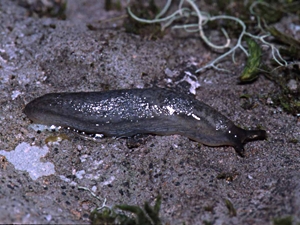 Brown-banded arion (Arion circumscriptus) from Thurston Co., Washington, USA. Picture: William Leonard (Calphotos). |
Description: The brown-banded arion is a small slug with a dark grey or brown colour, sometimes with a bluish hue. The mantle shield is darkly spotted, the body sides sometime are paler. A dark band stretches along either side of the body, the right one above the respiratory hole. The slug's back often can be very slightly keeled. The mucus is colourless, the foot sole is whitish. Juveniles have light grey sides.
When it is contracted, the slug's cross-section has a bell shape, like Arion fasciatus (see above). In phases of dormancy, the slug does not contract, like Arion silvaticus, but remains stretched.
The genital atrium of the brown-banded slug is very large, the epiphallus is strongly pigmented and wider than the spermioduct (Vas deferens). The oviduct is short and not narrow, the seminal pouch (spermatheca) is elongate.
Dimensions: L: Up to 50 mm.
Habitat and Distribution: Brown-banded arions live in cool and humid forest habitats, where they are often found on fallen logs. More rarely, like for example in Britain, they are found outside of forests and even in anthropogenous habitats. Arion circumscriptus feeds on the mycelia of mushrooms, but also on green plant parts, flowers and fruit. In Switzerland, the species lives in altitudes of up to 1600 m MSL.
The distribution area of the brown-banded arion originally stretched from North-western and Central Europe as far as Northern Italy. The species has at least been introduced in North America.
Threat Situation: While the brown-banded arion is common in Britain, its distribution is disperse in the rest of its area. In Austria, the species is endangered, in Bavaria, it is vulnerable. (See also: IUCN threat categories).
![]() Mollbase:
Arion circumscriptus.
Mollbase:
Arion circumscriptus.
![]() Francisco
Welter-Schultes:
Arion circumscriptus species homepage.
Francisco
Welter-Schultes:
Arion circumscriptus species homepage.
![]() Terrestrial Mollusc Tool:
Arion circumscriptus.
Terrestrial Mollusc Tool:
Arion circumscriptus.
Small arion or hedgehog arion - Arion (Kobeltia)
intermedius (Normand 1852)
![]()
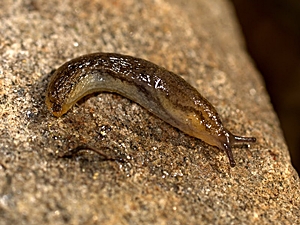 Hedgehog arion (Arion intermedius) from Portugal. Picture: Adolfo Outeiro (Source). |
Description: The small arion is a very small slug, creamy white until bluish yellow or olive brown. In exceptions, it can also have a greyish colour. At the sides of the back there can be darker zones, sometimes the slug can also have blurred dark lateral bands, the right one of which leads in a curve around the respiratory opening. The foot seam can be orange. Often, there are very differently coloured slugs in one populations. The tentacles are small and darkly coloured. The slug's mucus is light yellow. The breathing hole is about in the middle of the mantle shield or even behind the middle. The alternative name hedgehog arion comes from the spiky warts the slug displays in the contracted state.
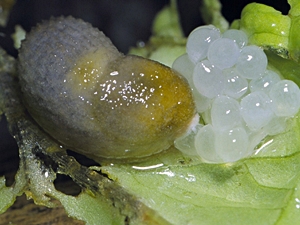 Hedgehog arion (Arion intermedius) from British Columbia (Ca- nada). Picture: Kristiina Ovaska (CalPhotos). |
Arion intermedius is different from Arion obesoductus morphologically in having a short oviduct lying freely.
Dimensions: L: Up to 25 - 35 mm.
Habitat and Distribution: The slug inhabits the leaf litter zone of humid deciduous and alluvial forests, as well as areas near water bodies. Arion intermedius is also present on silicate ground, unlike most gastropods. Apparently, the slug feeds on mushrooms. In dry times, the slugs aestivate contracted with an even contracted foot sole and camouflaged with earth particles. The hedgehog arion lives for a year, maturity is reached in autumn.
The species' distribution area covers Western and Central Europe, in the south to mainland Italy and Sicily, along the coast of Norway as far north as the 65th degree of latitude, but also to Iceland and the Faeroe Islands.
Threat Situation: In Central Europe the small arion is quite rare, but common and evenly distributed in Britain. In Switzerland and Bavaria, the small arion is of low concern.
![]() Mollbase:
Arion intermedius.
Mollbase:
Arion intermedius.
![]() Francisco
Welter-Schultes:
Arion intermedius species homepage.
Francisco
Welter-Schultes:
Arion intermedius species homepage.
![]() Terrestrial Mollusc Tool:
Arion intermedius.
Terrestrial Mollusc Tool:
Arion intermedius.
Alpine arion - Arion (Kobeltia)
obesoductus Reischütz 1973
![]()
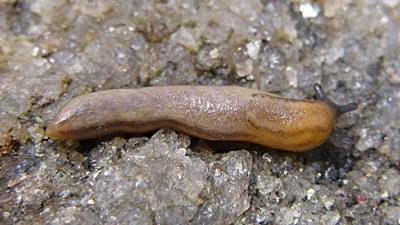 Alpine arion (Arion obesoductus ?) from the Czech republic. Picture: Michal Maňas (wikipedia). |
There are several systematic names for the Alpine arion. According to Manganelli et al. (2010), Arion alpinus Pollonera 1887 is a younger and therefore invaluable synonym of Arion intermedius. Arion alpinus auct. non Pollonera, meaning the specimens of Arion alpinus described by authors other than Pollonera, and not from the described finding area, as of current knowledge, are regarded as Arion obesoductus Reischütz 1973. There are findings from Piedmont and Lombardy, which currently cannot be determined with sufficient certainty.
Description: The Alpine arion is a very small slug of a yellowish white colour, with a light greyish brown dorsal band and dark grey-brown lateral bands. The body is covered irregularly with small warts or tubercles. The head and the tentacles are greyish blue, the foot sole is orange or yellowish in colour. The mucus is yellowish, which is a difference between Arion obesoductus and a juvenile Arion subfuscus.
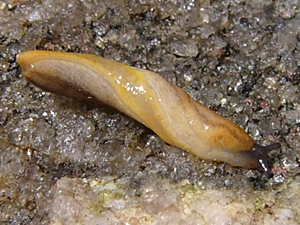 Alpine arion (Arion obesoductus ?). Picture: Michal Maňas (Source). |
The long oviduct runs freely and the epiphallus papilla is flattened. In contrary, Arion intermedius has a short oviduct and Arion distinctus has a conical epiphallus papilla.
Dimensions: L: 15 - 25 mm.
Habitat and Distribution: The Alpine arion lives in forests under the bark of fallen logs. Apparently it only lives in habitats close to nature and possibly feeds on mushrooms. The species' distribution area is not clearly determined: The species occurs from the Czech republic as far south as Northeast Italy and Southwest Germany. South Alpine findings, such as, like previously mentioned, Piedmont and Lombardy, are in discussion, but the anatomical data present are insufficient for a confirmation.
Literature
| Dvořák, L.; Backeljau, T.;, Reischütz, P. L.; Horsák, M.;, Breugelmans, K.; Jordaens, K. (2006): Arion alpinus Pollonera, 1887 in the Czech Republic (Gastropoda: Arionidae). Malacologica Bohemoslovaca. 5: 51-55. | ||
| Manganelli, G.; Bodon, M.; Giusti, F. (2010): The status of Arion alpinus Pollonera 1887, and re-description of Arion obesoductus Reischütz 1973 (Gastropoda, Arionidae). Journal of Conchology 40: 269-276. (Abstract). |
![]() Mollbase:
Arion alpinus.
Mollbase:
Arion alpinus.
![]() Mollbase:
Arion obesoductus.
Mollbase:
Arion obesoductus.
![]() Francisco
Welter-Schultes:
Arion obesoductus species homepage.
Francisco
Welter-Schultes:
Arion obesoductus species homepage.
Until some time ago, up to three different species had been described under the scientific name of Arion hortensis. Today, this species complex, consisting of the garden slug (Arion hortensis), the dark face arion (Arion distinctus) and the warty arion or Inishowen slug (Arion owenii) is also referred to as Arion hortensis agg. There is the possibility that further species might be hidden in this complex, so further scientific research is necessary.
![]() Terrestrial Mollusc Tool:
Arion hortensis group: Arion owenii.
Terrestrial Mollusc Tool:
Arion hortensis group: Arion owenii.
Contrary to earlier reports, the garden slug (Arion hortensis) obviously has got a smaller area of distribution, than has been assumed so far. The species is distributed only in Western Europe, between the Netherlands, Belgium, France, the western and southern parts of Germany and Nortehrn Switzerland. On the other hand, the dark face arion (Arion distinctus) is much more widely distributed, its distribution area covering most of what was so far reported for Arion hortensis agg. Both species, however, partly appear together (sympatrically). The third species, Arion owenii, so far could only be found in some regions on the British Isles.
Reports for Arion hortensis introduced in temperate regions overseas (New Zealand, South Africa and Australia) can only be retraced to the species complex, so it must be proved whether Arion hortensis or Arion distinctus has been found.
| De Winter, A.J. (1984): The Arion hortensis complex (Pulmonata: Arionidae): designation of types, descriptions, and distributional petterns, with special reference to the netherlands. Zoologische Mededelingen, 59(1): 1-17, 1984. | ||
| Allgaier, C. (2006): Nachweis der Koexistenz von Arion hortensis Férussac 1819 und Arion distinctus Mabille 1868 (Gastropoda, Pulmonata, Arionidae) in Tübingen (Baden-Württemberg). Jh. Ges. Naturkde. Württemberg, 162: 229–241, 2006 (PDF). | ||
| Iglesias, J.; Speiser, B. (2001): Distribution of Arion hortensis s.s. and Arion distinctus in Northern Switzerland. J. Moll. Stud., 67: 209-214, 2001. |
Garden slug - Arion (Kobeltia) hortensis
Férussac 1819
![]()
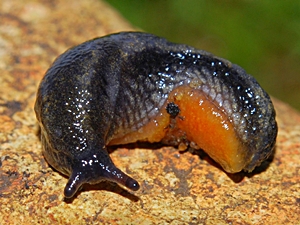 Garden slug (Arion hortensis) from England. Picture: Brian Eversham, (Source). |
 Arion fasciatus and Arion hortensis. Source: Livinglandscapes.bc.ca. |
Description: The garden slug is a small slug with a bluish grey colour and dark lateral bands, the right one of which runs above the respiratory hole. The tail end is bluish or orange coloured. The tentacles are bluish or reddish. The tubercles (see above) at the foot seam are white. In the contracted state, the cross-section of the slug's body is not bell-shaped like in Arion fasciatus. The foot sole is orange or yellow, the mucus is yellowish orange. Juveniles are characteristically bluish grey with a more darkly coloured back and a yellowish foot sole.
Dimensions: L: 30 - 40 mm, exceptionally up to 50 mm.
Habitat and Distribution: In nature, the garden slug lives in deciduous forests and in bush habitats. As a commensal species, like its name says, the garden slug often is found in gardens, parks, cultivated fields, cellars and warehouses. Garden slugs live in between the herbs and in the leaf litter, under stones and in crevices in the ground. In the North of the British Isles the garden slug is found exclusively as a commensal species.
Garden slugs basically are omnivores, but they prefer fruit (such as wild and cultivated strawberries), seedlings and young, weakened plants. Therefore, garden slugs can become very severe garden and green house pests (apart from the Lusitanian slug, the garden slug is among the most infamous garden pests in gastropods).
The distribution area of the species spreads from the British Isles (save Scotland and Northwest Ireland), the Netherlands until France, through Germany as far as South-Western Switzerland. In the Alps the species can be found in altitude of up to 2000 m MSL. In many other regions on Earth the garden slug has been introduced by man.
![]() Mollbase:
Arion hortensis.
Mollbase:
Arion hortensis.
![]() Francisco Welter-Schultes:
Arion hortensis species homepage.
Francisco Welter-Schultes:
Arion hortensis species homepage.
![]() Terrestrial Mollusc Tool:
Arion hortensis.
Terrestrial Mollusc Tool:
Arion hortensis.
Dark face arion - Arion (Kobeltia) distinctus Mabille
1868
![]()
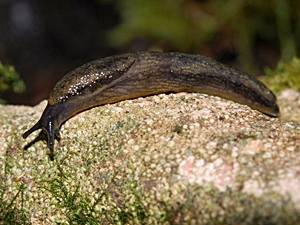 Dark face arion (Arion distinctus) from England. Picture: Brian Eversham, (Source). |
Description: The common garden arion or dark face arion generally is a small yellowish or brownish grey slug with dark bands are running along either side, at the bottom of the foot. The right hand band usually surrounds the respiratory opening. The warts (tubercles) at the foot seam are more lightly coloured, but not as white as in Arion hortensis. Head and tentacles and dark blue grey (hence the English name) and do not have a reddish hue. The foot sole is light yellow.
Dimensions: L: Up to 50 mm.
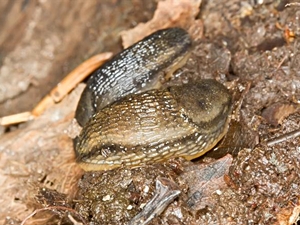 Dark face arion (Arion distinctus) from Norway. Picture: G. Drange (EOL). |
Habitat and Distribution: The dark face arion is commonly found in human-made habitats, hence also an alternative name: Common garden arion. In nature, Arion distinctus also appears in deciduous forests and in bush habitats, as well as in extensively used Alpine meadows. The darkface arion is soon to be found in areas left fallow by man and is also often displaced by man. It may become a harmful species in gardens and cultivated fields. In Switzerland, the species is found in altitudes of up to 2300 m MSL., but usually remains below 1500 m MSL. Arion distinctus feeds on green herbs, but also on fruit and might be responsible for much damage to cultivated strawberries.
The dark face arion is among the commonest and most widely spread slug species. Its distribution area stretches from Western and Central Europe as far as Northern Italy and Bulgaria, in the North to the British Isles, save the Hebrides, but including the Isle of Man, the Shetlands and Orkneys, and also the Faeroe Islands. In Scandinavia the northern limit of distribution is the 63rd degree of latitude. Also, the dark face arion has been introduced to Northern America.
![]() Mollbase:
Arion distinctus.
Mollbase:
Arion distinctus.
![]() Francisco
Welter-Schultes:
Arion distinctus species homepage.
Francisco
Welter-Schultes:
Arion distinctus species homepage.
![]() Terrestrial Mollusc Tool:
Arion distinctus.
Terrestrial Mollusc Tool:
Arion distinctus.
![]() Slugs - A Guide to the Invasive and Native Fauna of California (University
of California, 2009) (PDF, 1,5 MB).
Slugs - A Guide to the Invasive and Native Fauna of California (University
of California, 2009) (PDF, 1,5 MB).
![]() BBC:
Guide to Nottinghamshire Slugs.
BBC:
Guide to Nottinghamshire Slugs.

Wildlife Trust for Bedfordshire, Cambridgeshire,
Northamptonshire and Peterborough.